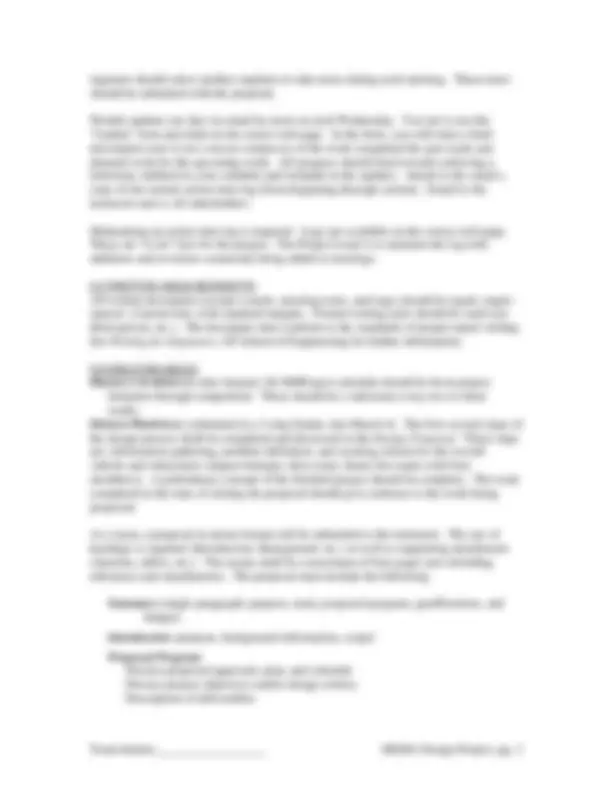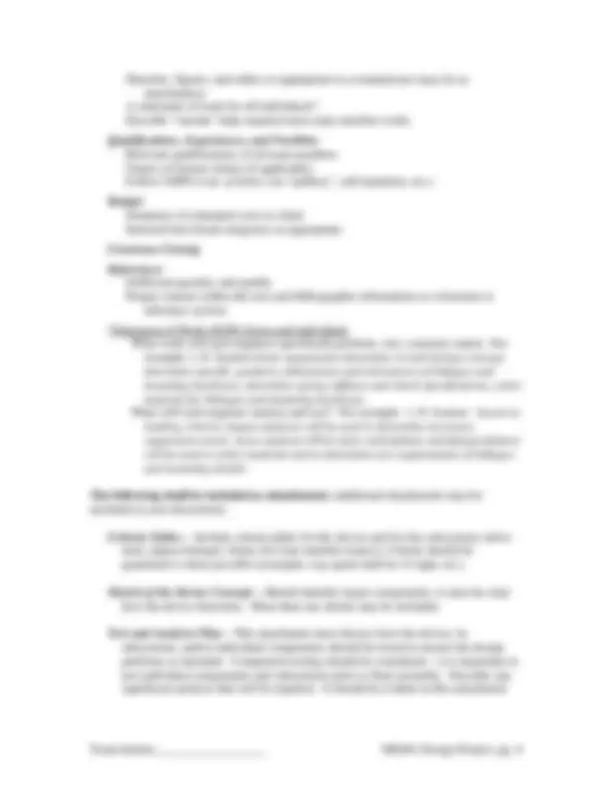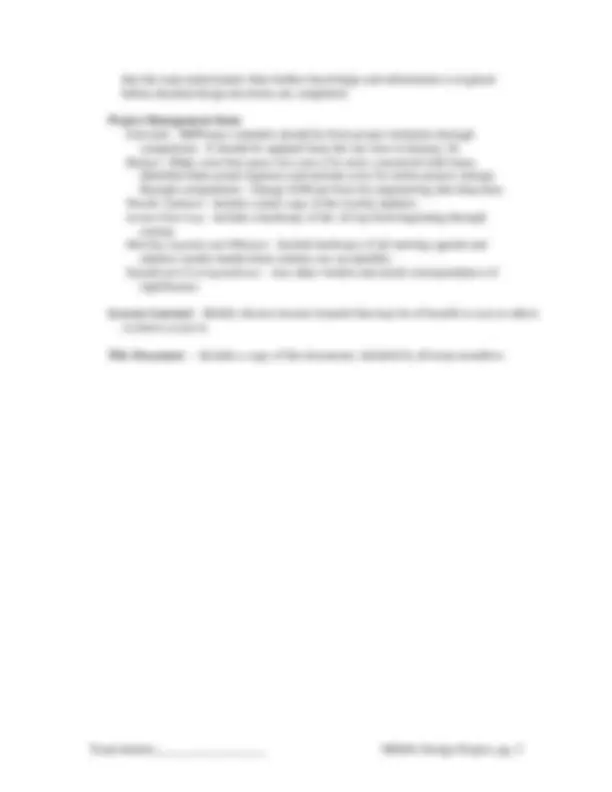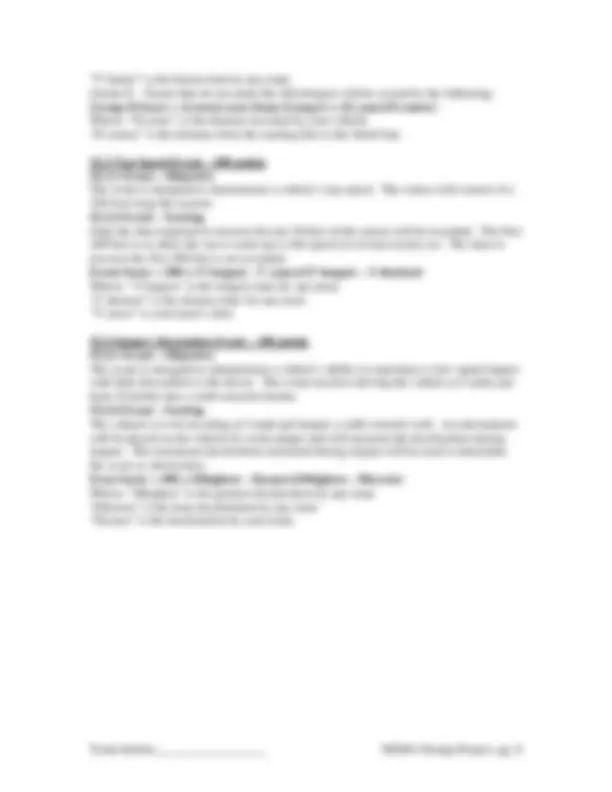






Study with the several resources on Docsity

Earn points by helping other students or get them with a premium plan


Prepare for your exams
Study with the several resources on Docsity

Earn points to download
Earn points by helping other students or get them with a premium plan
Community
Ask the community for help and clear up your study doubts
Discover the best universities in your country according to Docsity users
Free resources
Download our free guides on studying techniques, anxiety management strategies, and thesis advice from Docsity tutors
Material Type: Project; Professor: Lulay; Class: Machine Design; Subject: Mechanical Engineering; University: University of Portland; Term: Spring 2009;
Typology: Study Guides, Projects, Research
1 / 8

This page cannot be seen from the preview
Don't miss anything!





University of Portland ME401 Machine Design Project Description, Spring 2009
Students, please note you are required to submit a copy of this document in the appendix of your ME 401 Project proposal. All team members must initial each page of this document indicating that you have read and understand the requirements (1 copy per team). If you do not understand the requirements, please ask for clarification.
1.0 OBJECTIVES The educational purpose of this project is to provide an opportunity for students to practice and learn basic project management skills and to increase their understanding of the iterative and team nature of design projects. The teams will be created by the instructor and shall consist of three or four members. Through this project students shall demonstrate their ability to:
2.0 ORGANIZATION Each member is to be the “Lead Engineer” responsible for semi-detailed design of one component (the team is to figure out whom). Each team is to select a Project Lead Engineer. The Project Lead will be responsible for the overall integration of all subsystems, support team cohesiveness and mitigate obstacles, managing the schedule (making sure all the necessary work is getting done on schedule), and maintaining an action item log. The Project Lead will also be responsible for designing one component. In addition to their own component, each engineer may need to assist their teammates with their tasks.
3.0 PROJECT CONTEXT Many professional societies (such as ASME and SAE) sponsor collegiate design competitions. These competitions provide excellent opportunities for students to develop an in-depth understanding of the design process (concept through manufacturing and testing) and to evaluate their designs against other students’. However, students selecting such a project for senior design should be aware of the commitment required. Often, substantial fundraising is required, and the challenges with fabricating and assembling the design are extensive. However, the rewards are great. The ME401 project is modeled after the SAE Baja design competition but has been modified in order to incorporate various aspects of design.
The objective of this project is to design a vehicle for a fictitious Society of Automotive Engineers design competition. The competition is to take place on April 15, 2010 in Waukesha, Wisconsin. For ME 401, the project will have duration of about six weeks and will involve only initial stages of the design project. The only deliverables for the
ME401 Project is a schedule (due in one week) and design proposal (due approximately mid-semester). Weekly progress reports (updates) will also be required.
When creating the schedule, assume the deliverables for the fictitious project include: a written design report due 4 weeks prior to the competition, a formal oral design presentation given to a panel of engineering judges, and a functioning vehicle to enter in the competition described in the appendix. None of these deliverables are to be produced for ME401, they are included here only for the sake of planning.
4.0 DESIGN COMPETITION The purpose of the design competition is for students to develop a single-seat off-road electric powered vehicle, very similar to SAE Baja competition. Being an off-road vehicle, it will be evaluated based on top speed and ability to climb hills and accelerate. Further project descriptions (rules) are given in the appendix.
The primary differences between this competition and Baja are the pneumatic impact bumper event and the motor to be used (electric rather than internal combustion). The vehicle must use the electric motor characterized by the performance curve provided on the course web page. The pneumatic “shock absorber” bumper must allow the vehicle to hit a solid concrete wall head-on while traveling 5 mph (8 km/hr). After initial contact with the wall, the vehicle must come to rest in a distance of 8 inches (20 cm) or less, with minimal deceleration.
5.0 DEVICE SUBSYSTEMS Each student shall be the lead engineer responsible for semi-detailed design of one component. The following are the required from each team:
For specific details, please see the attachment, the instructor or the course web page.
6.0 PROJECT MANAGEMENT Along with a schedule, other project management tools are required. These include Action Item Logs, project updates, and meeting agenda and minutes.
Each team must have periodic scheduled meetings (the meetings should be shown on the project schedule ). The engineer running the meeting must have an agenda that is emailed to all stakeholders two to seven days prior to the meeting and send all meeting minutes to all stakeholders within two business days after the meeting. Each student is responsible for running at least one meeting during the semester. This
Sketches, figures, and tables as appropriate to communicate (may be as attachments) A statement of work for all individuals* Describe “outside” help required (non-team member work) Qualifications, Experiences, and Facilities Relevant qualifications of all team members Names of former clients (if applicable) Follow NSPE Code of Ethics (no “puffery”, self-laudation, etc.) Budget Summary of estimated costs to client Itemized into broad categories as appropriate Courteous Closing References Sufficient quantity and quality Proper citation within the text and bibliographic information as a footnote or reference section *Statement of Work (SOW) from each individual: What work will each engineer specifically perform, very concisely stated. For example: I. R. Student (front suspension) determine overall design concept, determine specific geometry (dimensions and tolerances) of linkages and mounting hardware, determine spring stiffness and shock specifications, select material for linkages and mounting hardware. What will each engineer analyze and test? For example: I. R. Student: based on loading criteria, impact analysis will be used to determine necessary suspension travel, stress analysis (FEA-static yield failure and fatigue failure) will be used to select material and to determine size requirements of linkages and mounting details.
The following shall be included as attachments (additional attachments may be included at your discretion) :
Criteria Tables – Include criteria tables for the device and for the subsystems (drive train, impact bumper, frame (for four member teams)). Criteria should be quantitative where possible (examples: top speed shall be 15 mph, etc.).
Sketch of the Device Concept – Should identify major components, it must be clear how the device functions. More than one sketch may be included.
Test and Analysis Plan – This attachment must discuss how the device, its subsystems, and/or individual components should be tested to ensure the design performs as intended. Component testing should be considered – it is important to test individual components and subsystems prior to final assembly. Describe any significant analysis that will be required. It should be evident in this attachment
that the team understands what further knowledge and information is required before detailed design decisions are completed.
Project Management Items Schedule : MSProject schedule should be from project initiation through competition. It should be updated from the one turn in January 28. Budget : Make your best guess for costs (I’m more concerned with items identified than actual expense) and include costs for entire project (design through competition). Charge $100 per hour for engineering and shop time. Weekly Updates : Include a hard copy of the weekly updates. Action Item Log : include a hardcopy of the AI log from beginning through current. Meeting Agenda and Minutes : Include hardcopy of all meeting agenda and minutes (neatly handwritten minutes are acceptable). Significant Correspondence: Any other written and email correspondence of significance.
Lessons Learned – Briefly discuss lessons learned that may be of benefit to you or others on future projects.
This Document – Include a copy of this document, initialed by all team members.
52.1 Acceleration – 100 Points 52.1.1 Acceleration – Objective Acceleration determines the time it takes the vehicle to accelerate along 30.48 m (100 ft) flat course. 52.1.4 Acceleration – Scoring Teams with acceleration times that are more than twice that of the fastest car will not receive a score for this event. Teams attempting the event, but exceeding the time limit will be classified as “Excess Time”. The following equation will be used for the acceleration score: Acceleration score = 100 [(T longest – T yours)/(T longest – T shortest)] Where: “T shortest” is the fastest time by any team “T longest” is either (a)the slowest time by any team or (b) 2.5x the fastest time whichever is the shorter interval “T yours” is your team’s best time
52.2 Hill Climb Event – 100 Points 52.2.1 Event – Objective The event is designed to demonstrate the vehicle’s hill climbing ability. The course will consist of a 50 foot long flat section, followed by a 100 foot long 20 degree incline, followed by a 100 foot 35 degree incline. 52.2.4 Event – Scoring Method A : “Different Distances” - In the most common instance where the vehicles climb the hill to a variety of distances the score will be determined by the following formula: Event Score = 100 x [(D yours – D shortest)/(D longest – D shortest)] Where: “D shortest” is the shortest distance by any team “D longest” is the longest distance by any team “D yours” is your team’s distance Method B : “Fixed Distance-All Succeed” - Where there is (a) a set maximum distance and (b) all teams succeed in completing a full distance hill or pull, then the score will be based on the time of the full distance covered and calculated by the following formula: Event Score = 100 x [(T longest – T yours)/( T longest – T shortest)] Where: “T longest” is either (a) the longest time through the course by any team or (b) 2.5 x “T shortest” whichever is the shorter time “T shortest” is the shortest time by any team “T yours” is your team’s best time Method C : “Fixed Distance-Some Succeed” - Where there is (a) a set maximum distance and (b) at least one team climbs the hill or makes a full pull and others do not, then the vehicles going the full distance (Group I) will be scored based on time and the vehicles that fail to climb the hill or make a full pull (Group II) will be scored based on distance. Scoring will be by the following formulas: Group I – Teams that make the full distance will be scored by the following: Group I Score = 100 x (T fastest/ T yours) Where: “T yours” is your team’s time
“T fastest” is the fastest time by any team Group II – Teams that do not make the full distance will be scored by the following: Group II Score = (Lowest score from Group I) x (D yours/D course) Where: “D yours” is the distance traveled by your vehicle “D course” is the distance from the starting line to the finish line
52.3 Top Speed Event – 100 points 52.3.1 Event – Objective The event is designed to demonstrate a vehicle’s top speed. The course will consist of a 250 foot long flat section. 52.3.4 Event – Scoring Only the time required to traverse the last 50 feet of the course will be recorded. The first 200 feet is to allow the car to come up to full speed (or at least nearly so). The time to traverse the first 200 feet is not recorded. Event Score = 100 x (T longest – T yours)/(T longest – T shortest) Where: “T longest” is the longest time for any team “T shortest” is the shortest time for any team “T yours” is your team’s time
52.4 Impact Absorption Event – 100 points 52.4.1 Event – Objective The event is designed to demonstrate a vehicle’s ability to experience a low speed impact with little discomfort to the driver. The event involves driving the vehicle at 5 miles per hour (8 km/hr) into a solid concrete barrier. 52.4.4 Event – Scoring The vehicle is to be traveling at 5 mph and impact a solid concrete wall. Accelerometers will be placed on the vehicle by event judges and will measure the deceleration during impact. The maximum deceleration measured during impact will be used to determine the score as shown here. Even Score = 100 x (Dhighest – Dyours)/(Dhighest – Dlowest) Where: “Dhighest” is the greatest deceleration by any team “Dlowest” is the least deceleration by any team “Dyours” is the deceleration by your team.